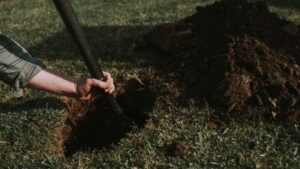Why Aldoro’s Kameelburg could become a global top 3 niobium-REE deposit

Aldoro believes Kameelburg has the potential to rank as a top 3 REE- niobium deposit as more assays are received. Pic: Getty Images
- Aldoro receives standout results from latest drilling at Kameelburg
- Hole DD006 extends mineralisation 650m to the southwest
- More drilling is planned with a resource anticipated by quarter end
Special report: Aldoro’s second batch of assays from Kameelburg, Namibia, has delivered the highest grades of niobium and rare earths recorded so far, confirming a substantial southwest extension of the world-class polymetallic discovery.
Assays for holes ND004D and DD006 ended in mineralisation and remain open at depth, with DD004D returning the highest grade yet of 293m at 3.67% total rare earth oxide equivalent (2.1% TREO, 0.21% niobium and 448ppm molybdenum) from 3m.
Drill hole DD006 successfully intersected enriched REE, niobium, and molybdenum mineralisation, extending the known zone by roughly 650m to the southwest of drill holes DD004, ND004A, and DD004C.
The confirmation of a 650m southwest extension has doubled the scale of Aldoro’s (ASX:ARN) Kameelburg discovery, which now spans 1.2km by 650m with a depth of 510m.
With mineralisation still open at depth and additional assay results pending, further upside potential remains.
Drill hole DD006 hit 293m at 3.13% TREO equivalent (1.68% TREO, 0.20% niobium and 395ppm molybdenum) from 2m comprising in the upper REE dominant layer.
In the lower niobium dominant layer, the hole returned an assay of 87m at 2.31% TREO equivalent (0.71% TREO, 0.25% niobium and 232ppm molybdenum).
Echoes of Niobec Saint-Honoré deposit
ARN sees geological and mineralogical parallels between Kameelburg and the Niobec Saint-Honoré REE-niobium carbonatite deposit in Quebec, which hosts an average niobium pentoxide grade of 0.41% over 416Mt and a TREO grade of 1.83% across 527.2Mt.
The explorer notes that both deposits exhibit similarities in aerial extent and in hosting rare earths and niobium mineralisation.
While the Saint-Honoré deposit lies hidden beneath layers of limestone and weathered carbonatite—some 110 to 150m deep—its niobium and REE zones span just 48 and 34 hectares, respectively.
Kameelburg, by contrast, dominates the landscape – a towering 275m high carbonatite structure spread over a vast 160 hectares, fully exposed above the peneplain.
The Niobec deposit is currently owned by Magris Resources who acquired the project for US$530 million in January 2015.
That gives a sense of the value placed by the market on deposits with similar scale and geological attributes to Kameelburg, with ARN currently trading at a market cap of $60m.
Global top 3 potential
ARN chairperson Quinn Li said the company is looking forward to receiving the remaining assays in the coming weeks.
A maiden mineral resource estimate is on the way, which could confirm Aldoro’s internal assessment of Kameelburg as a top 3 REE-NB deposit globally.
“On behalf of myself and our shareholders, a great deal of appreciation goes to our exploration manager and technical director, Dr Minlu Fu, who has worked tirelessly to advance the Kameelburg project from exploration prospect to a globally significant REE-Nb discovery with forthcoming MRE in a little over 10 months,” she said.
“We also appreciate our drilling crew who have worked unabated for the past 5 months ensuring the Phase I diamond drilling program is completed on time and at a cost of under US$65 per diamond metre drilled, saving the company significant costs and subsequently reducing potential shareholder dilution,” she added.
Kameelburg is ~300kms north of Windhoek, the capital of Namibia, and 60 kms southwest of Otiwarongo along well-maintained bitumen roads.
The Industrial Port of Walvis Bay is 355km southwest of Kameelburg, which are connected by the TransNamib heavy haul freight railway (passing within 1km of Kameelburg).
Recent drilling at the project has highlighted a clear zonation pattern with the upper layer being enriched in rare earths, forming a rare earthniobium-molybdenum deposit and the lower layer being niobium-rich, forming a niobium-rare earth deposit.
New supply avenues
With China enacting export controls on key rare earths and permanent magnets, ARN’s timing aligns with a growing global push to secure alternative supply sources.
China is the world’s largest producer of rare earths by a significant margin, producing 60% of the world’s rare earths and processing about 90% of the world’s rare earths and magnets.
Niobium meanwhile is even more highly concentrated in a single producer, with over 80% of the world’s supply coming from a single mine in Brazil.
Kameelburg could contribute to establishing alternative supply chains, should the project advance to production.
M&A also continues to be an influencing factor in the REE space driven in part by recent global trade conflict as well as the REE export restrictions impacting global supply chains and positively impacting REE pricing.
This is highlighted by the recent $150.5m acquisition of Peak Rare Earth’s (ASX:PEK) and its 214.4mt MRE grading at 2.15% TREO by China’s Shenghe Resources.
Rare earth elements underpin critical AI hardware components, from neodymium-based magnets in storage drives to terbium-doped optical fibres.
These elements are used in everything from powerful magnets found in cooling fans and hard drives to sophisticated components for servers and networking equipment.Analysts forecast a significant surge in demand for AI-driven technologies—including autonomous vehicles, robotics, and smart devices—over the next decade, placing additional pressure on already-stretched supply chains.
Resource by quarter end
Li said the company intends to begin exploration drilling over the covered carbonatite at Kameelburg, which if successful, will elevate the deposit into the scale that is comparable to China’s Bayan Obo deposit – the largest REE deposit and the second largest niobium deposit globally.
Further assays are expected in the coming weeks and will assist in determining the extent of the mineralisation in the East and West direction.
A total of 19 diamond drill holes are planned for the 8500-metre Phase I drilling program of which 6497m have been completed to date.
ARN is working closely with an independent consultant to deliver a resource by the end of this quarter.
This article was developed in collaboration with Aldoro Resources, a Stockhead advertiser at the time of publishing.
This article does not constitute financial product advice. You should consider obtaining independent advice before making any financial decisions.
Related Topics

UNLOCK INSIGHTS
Discover the untold stories of emerging ASX stocks.
Daily news and expert analysis, it's free to subscribe.
By proceeding, you confirm you understand that we handle personal information in accordance with our Privacy Policy.








